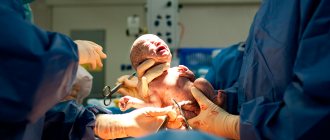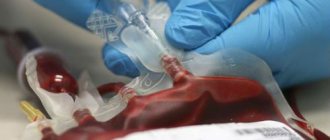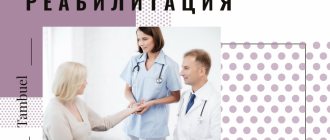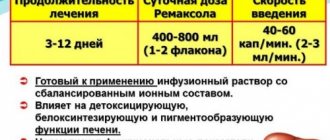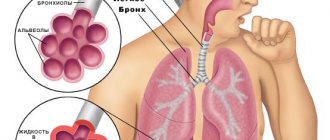- Caesarean section - what is it?
- Indications for use
- How is a caesarean section performed?
- Types of caesarean section
- Recovery phase
The surgical procedure to deliver the baby is called a caesarean section. A woman does not give birth on her own; the fetus and placenta are removed through an incision in the peritoneum. Recently, there has been a tendency to increase the number of such operations (26-32%). This is due to the average age of women giving birth - over 30 years old. By this time, the number of extragenital pathologies in women increases, and a complicated obstetric and gynecological history appears. Indications for cesarean section are usually the unsatisfactory condition of the mother or fetus, or the risk of complications during natural childbirth.
Preparation
- 7 - 10 days before the expected date of birth, you will be hospitalized in the antenatal department of the maternity hospital and a date for surgery will be set. Typically, PCS is performed at 38–39 weeks.
! In many modern maternity hospitals, the expectant mother is allowed to come to the ACL on the day of the operation.
- For ACL, you will need to buy special compression stockings or bandages to protect the vessels of the legs from the formation of blood clots;
- On the day of the operation you should not drink or eat - the doctor will remind you of this;
- Two hours before the PCS, you will have a cleansing enema.
Anesthesia during surgery
Today there are 2 main options for pain relief:
- Regional anesthesia (elected caesarean section with epidural or spinal anesthesia) is preferred;
- Sometimes general anesthesia is performed - in this case, the woman sleeps until the end of the operation.
With epidural anesthesia, a drug is injected into the space surrounding the spinal cord, in the lumbar region. A catheter is installed there, through which the medicinal substance is added during and after the operation. During spinal anesthesia, the drug is injected directly into the spinal canal - and then the injection is given once.
How is a caesarean section performed?
- In the preoperative room, you will have a urinary catheter and a catheter in your arm to quickly administer medications;
- The anesthesiologist will administer anesthesia. In 90% of cases, epidural (spinal) anesthesia is used for caesarean sections, both planned and emergency. It immobilizes only the lower part of the body and allows the mother to remain conscious during the birth of the child. Sometimes with ECS, if the operation needs to be performed as quickly as possible, general anesthesia is given;
- Once the anesthesia has taken effect, you will be taken to the operating room. There you will be placed on a table, your arms and legs will be fixed, your stomach will be wiped with an antiseptic and a special curtain will be hung so that you cannot see the medical manipulations;
- The doctor will make a small longitudinal incision on the abdominal wall and the wall of the uterus through which the baby will be removed. He will then cut the umbilical cord, hand the baby over to the midwife and remove the placenta;
- All tissues will be sequentially sutured with absorbable threads, a suture will be placed on the skin and covered with a sterile bandage. The entire operation lasts from 20 to 40 minutes.
Rumyantseva, md.
I think all readers know that a caesarean section is an operation by which a child is born (the most common alternative to natural childbirth). About 30% of children are born via caesarean section.
Caesarean section is a life-saving service for the child and woman in some situations (for example, placenta previa, uterine rupture during childbirth). And yet there is still talk about the need to reduce the proportion of births by caesarean section. Why? Let's try to figure it out!
Quick links:
- Indications for caesarean section
- How is a caesarean section performed?
- After a cesarean section
- Suture care after cesarean section
- Possible complications
- Natural birth after cesarean section
- Pros and cons of childbirth by cesarean section compared to natural childbirth
- What you should know if you really want a natural birth, but there are suspicions that the birth will take place by caesarean section
- What you should know if you really want a caesarean section, but there are no indications for it
- Can I influence my chances of having an emergency C-section if labor has already started (or what can I do to increase my chances of having a vaginal birth)?
- Labor has already started, the chance of a caesarean section is never zero, which means you can't eat or drink during the entire process?
Indications for caesarean section:
A caesarean section is mandatory and urgent if:
- there is a danger to the life of the fetus: slowing of the fetal heartbeat or changing heart rate during childbirth, the release of meconium during childbirth with ruptured membranes, prolapse of the umbilical cord;
- there is a danger to the mother’s life: massive bleeding, a sharp increase in blood pressure readings;
- there are mechanical obstacles to the birth of a child: the narrowness of the mother’s birth canal and/or the fetus is too large. The dimensions of the mother's pelvis are measured upon registration at the antenatal clinic; if a woman has one or another type of pelvic narrowing, careful monitoring is carried out over the expected size of the fetus, and labor management tactics are based on the correspondence between the sizes of the mother’s birth canal and the fetus’s head;
- weakness of labor: lack of increase in the strength of contractions and the corresponding movement of the child along the birth canal, not amenable to drug correction.
A caesarean section is most often performed if:
- previous deliveries were performed by caesarean section. But this is far from necessary; Now in many maternity hospitals you can give birth on your own after a caesarean section;
- there is placenta previa: a situation in which it is not the head or pelvic end of the fetus that is present to the internal os (“the exit from the uterus”), but the placenta;
- the fetus is not in a cephalic presentation (breech, transverse position of the fetus). I note that a couple of decades ago, breech presentation was not an indication for a cesarean section; Currently, in Russian regulatory documents, the indication for surgery is fetal weight less than 2500 g and more than 3600 g for breech presentation;
- there are large tumors/cysts in the mother’s pelvic cavity;
- By the time of birth, the mother had worsened genital herpes and/or anogenial warts (condylomas): i.e. there are herpetic rashes or massive papillomas on the genitals;
- the mother has non-gynecological serious health problems: arterial hypertension, diabetes, retinal problems, etc.;
- , triplets and more fetuses will be born
- the mother has HIV infection: then childbirth by caesarean section reduces the likelihood of infection of the child (under certain conditions, natural birth is possible, see below).
How is a caesarean section performed:
Currently, caesarean sections are most often performed under epidural or spinal anesthesia. The woman is conscious, and she hears and sees her baby within a few minutes after the start of the operation (tissues are cut and separated quite quickly, but layer-by-layer suturing will take longer).
The incision is often made horizontally in the lower abdomen. The scar after surgery is usually very thin and invisible; there is no need to be afraid that it will ruin your appearance. After healing, it usually hides well under underwear
Sometimes the incision is made vertically, then the scar will be more noticeable (the incision will be quite large). Fortunately, this situation is quite rare. The following incision is made:
- if the previous caesarean section was performed in this way,
- if it is technically impossible to make a horizontal incision,
- if a completely unforeseen and emergency situation occurs (sometimes it’s faster to end the birth this way).
If everything goes well, mother and baby can cuddle and perform their first breastfeeding right after the operation is completed!
After a cesarean section
After the operation you will have to spend some time in intensive care. Your vital signs will be monitored at all times in the intensive care unit. However, this does not mean that you will have to delay starting breastfeeding (discuss this point with your doctor in advance, please).
And yes, the seam will hurt. But there is no need to be a hero! You can use painkillers, discuss and complain if it hurts!
You will have to spend some time in bed, but very soon (often within the first day) you will be able to get up, although it will not be easy. Be sure to call someone (nurse, doctor) before you try to get out of bed for the first time after surgery. Soon after the operation (or rather, when you can already walk to the toilet on your own), the urinary catheter will be removed (don’t be afraid of it, it will be with you at first).
You can eat and drink whenever you want (with your doctor's permission, of course).
Often, blood clotting therapy will be prescribed after surgery. They should tell you and show you which drugs should be used, how and for how many days.
Discharge can be early (2-4 days after birth) or a little later (usually no more than 7 days, if there are no complications). Check with your doctor when you are scheduled to be discharged so that everyone at home has time to prepare for your return!
At home, you should take care of yourself, not allowing yourself unnecessary stress in the first time after surgery.
You should abstain from sex and sports for 6 weeks (if there is an urgent need for one or the other earlier, you should discuss this issue with your doctor!).
Don't forget about contraception when you resume sexual activity. The absence of menstruation (if the child is breastfed) does not mean the inability to become pregnant. After a caesarean section, it is especially important to prevent the next pregnancy from occurring too early, so that you can carry your next child without fear for his or her condition.
Suture care after cesarean section
Pain in the suture area may bother you for several weeks, be sure to discuss with your doctor what you can use for pain relief before discharge!
Keep an eye on the seam area. Increased pain, redness, the appearance of copious discharge in the suture area, as well as a local or general increase in temperature - this is definitely a reason to see a doctor!
At home, try not to wear tight clothes. Friction and excessive sweating in the area of the suture will not speed up its healing. It is because of this that it makes sense to avoid driving the car for a while (so that the seat belt does not come into contact with the seam area).
Many women find it more comfortable to move around in a bandage after a cesarean section. Try wearing a bandage, but if it makes you uncomfortable/hot/painful, don't strive to use it all the time.
The suture needs care; the maternity hospital will show you how and what to do! Nothing terrible or complicated, but the ostrich position (not peeling off the patch and not looking at the seam) is not the best tactic.
By the way, the stitches most often do not need to be removed (they will dissolve on their own). If threads have been used that will have to be removed, you will definitely be informed about this!
Possible complications (fortunately, quite rare in the modern world):
- Infectious complications (from suppuration in the scar to sepsis)
- Blood loss (and possible subsequent coagulation disorders)
- Thrombosis, thromboembolism
- Injuries to the bladder and intestines
- Allergic reactions to the drugs used.
Monitor your condition carefully and be sure to tell your doctor if you have any unpleasant symptoms (fever, weakness, cough, pain in any area other than the suture (or increased pain in the suture area), problems with urination/defecation)!
What's next? C-section only for subsequent children?
After a caesarean section, natural childbirth is possible if the woman wants it!
Previously, it was believed that after a caesarean section you should not become pregnant for three years, but now it is recommended to wait a year after the operation, then the chances of a calm pregnancy and natural childbirth are higher (if the woman wants this).
Pros and cons of childbirth by cesarean section compared to natural childbirth:
Minuses:
- the likelihood of severe complications in the mother (bleeding requiring removal of the uterus or blood transfusion; uterine rupture; cardiac arrest; thromboembolism, etc.) is 3 times higher with a cesarean section;
- the likelihood of death for the mother is 3 times higher during a caesarean section;
- amniotic fluid embolism is 2-5 times more likely during cesarean section;
- placental abnormalities are more common after cesarean section (the risk increases with each subsequent delivery by cesarean section);
— it is possible (admittedly, very unlikely) that the child may be injured by a scalpel;
- according to some data, the risk of respiratory disorders in a child after a cesarean section is higher;
— after a caesarean section there is a higher risk that the child will end up in intensive care for various reasons.
Pros:
+ perineal rupture with serious consequences does not occur during caesarean section;
+ shoulder dystocia is possible only during natural childbirth;
+ For some women, caesarean section is the preferred method due to fear of pain during natural childbirth.
Occurs with equal probability after natural childbirth and after cesarean section:
= urinary incontinence;
= postpartum depression.
It’s worth making a reservation right away: when we talk about risks after a cesarean section, we must keep in mind that a cesarean section is often (not always, of course) carried out according to indications, that is, initially there are “aggravating” circumstances that contribute to the frequency of adverse consequences.
So, what you should know if you really want a natural birth, but there is a suspicion that the birth will take place by caesarean section:
- Indications during labor (weak labor, fetal heart rhythm disturbances, uterine rupture, bleeding, etc.)
- no amateur performances! During childbirth, the doctor makes decisions, and the doctor also takes responsibility for you! If the doctor suddenly, after the onset of labor, says that it is now necessary to perform a caesarean section, you must obey (for the sake of the child’s health, first of all).
- Breech presentation of the fetus
- an attempt at external obstetric rotation (turning the fetus at 37 weeks of pregnancy) is possible (and indicated). This is a particularly important topic for me, as some know. Read more about external obstetric rotation here. Important! This manipulation should only be performed by experienced doctors who know how to rotate! As far as I know, there are not very many of these in Russia! Don't demand a turn from a doctor who has never done one before. The success rate is far from 100%, but with a successful rotation, a natural birth in the cephalic presentation is possible.
- Large fruit
- yes, natural childbirth with a large fetus (especially if it is the first birth) is difficult. But if a woman wants to try, it is worth considering that a cesarean section is strictly indicated for an estimated fetal weight of 5 kg or more (which happens extremely rarely). If the fetal weight is below 5 kg, natural childbirth can be discussed (if the woman wishes and the experience and attitude of the doctors).
- "Little Fruit"
- if, according to ultrasound data, you are told that the child is too small (in the absence of developmental anomalies), then this fact in itself should not serve as an indication for a cesarean section (outcomes for such babies do not improve after cesarean section).
- Twins
— first, let’s clarify that three or more fetuses are an indication for a cesarean section. No reasoning. But twins with a cephalic presentation of the first fetus and any presentation of the second is the basis for attempting a natural birth. Delivery by cesarean section with this fetal arrangement does not improve outcomes for mother and children. Again, for natural birth of twins you need a great desire of the woman and the experience of obstetricians!
- Genital herpes
- herpetic eruptions on the genitals at the time of childbirth - this is a fairly compelling argument in favor of a cesarean section. However, there are prophylactic regimens of antiviral drugs that help avoid rashes at the time of delivery. Be sure to discuss the possibility/need of taking antiviral medications if you have ever had genital herpes (during or before pregnancy). Important! Genital herpes, which bothered you during pregnancy (1-2 trimester), but does not bother you at the time of birth, is not a reason for a cesarean section
- Premature birth
— Premature birth is always stressful for a woman. If the child’s condition does not suffer, then a natural birth is possible (a caesarean section will not provide a better outcome for the child). But! Doctors should tell you that the baby is not suffering and there are no other indications for a cesarean section other than preterm labor.
- Mom's weight
— weight control during pregnancy is important for many reasons (in particular, the more a woman gains during pregnancy, the higher her risk of cesarean section), but there is no BMI cutoff above which only cesarean section is indicated. Therefore, it is worth monitoring your weight (both during pregnancy and outside) in order to prevent obesity, but weight (without other aggravating circumstances) should not influence the choice of birth option.
- HIV positive mother
— undoubtedly, every woman wants to minimize the risks of infection for her child. If a woman receives adequate therapy and the viral load is low (below 50-400 copies/ml), then cesarean section does not provide an advantage in terms of the risk of infection of the child, and therefore the choice between vaginal birth and cesarean section should not be made solely on the basis of HIV-positive mother's status. At the same time, for women who are not receiving therapy and/or have a load above 400 copies/ml, a cesarean section is recommended.
- Hepatitis B in mother
- if a woman gives birth in a maternity hospital, which can provide proper manipulations for the child after birth (immunoglobulin administration, vaccination), then the risk of infection does not depend on the method of delivery, and therefore natural childbirth is possible.
- Hepatitis C in mother
- Caesarean section does not reduce the risk of infection of the child if the mother has hepatitis C (natural birth is possible). BUT! If you are infected with both HIV and hepatitis C, the risk of infection for the baby is reduced with a cesarean section, so these women should have a cesarean section.
And what you should know if you really want a caesarean section, but there are no indications for it:
- Review the section on the pros and cons of a cesarean section.
- Discuss your fears with your doctor: what exactly and why you are afraid. Perhaps the doctor can clarify some points for you. Be sure to talk about this topic with a doctor you trust.
- If you feel the need for this, talk to a perinatal psychologist.
- Despite the fact that in the orders of the Ministry of Health there is no indication for a caesarean section “a woman’s desire”, many international recommendations agree that if a woman is categorically determined to have a caesarean section, she has the right to it. If you are terrified of natural childbirth, do not overstep yourself.
Can I influence my chances of having an emergency C-section if labor has already started (or what can I do to increase my chances of having a vaginal birth)?
The main rule is to listen to doctors and yourself during childbirth. On the part of the woman, no special actions have yet been invented that will increase the chance of natural childbirth and reduce the risk of cesarean section.
But here’s what doesn’t affect whether the birth ends with a cesarean section:
- A woman’s activity during childbirth (if you want, go, if you don’t want, don’t!);
- Position of the woman during childbirth (on her back, sitting, upright, whatever);
- Finding a woman in the water
- Use of epidural anesthesia
- Acupuncture (before or during childbirth)
- Aromatherapy
- Hypnosis
- Herbs in any form
- dietary supplements
- Homeopathy
And one more question: labor has already begun, the probability of a caesarean section is never zero, which means that you cannot eat or drink during the entire process?
Where are all these conversations coming from? Not eating or drinking during labor is associated with the potential risk of gastric aspiration during anesthesia (a situation in which stomach contents enter the airway, blocking it partially or leading to pneumonia later in life).
But it turns out that the data regarding this risk is ambiguous, and therefore there is no strict ban on food during childbirth (it is better to choose something small and filling: cookies, cheese, etc.). And water and other liquids do not carry additional risks (on the contrary, drinking during childbirth is good), because do not lead to a significant increase in gastric volume and do not increase the risk of aspiration.
No matter how your birth goes, the most important thing for both you and the baby is the health and peace of mind of both mother and baby! Take care of yourself, enjoy your children and do not be afraid of childbirth in any form.
Sources:
- https://www.acog.org/Patients/FAQs/Cesarean-Birth#type
- https://www.acog.org/Clinical-Guidance-and-Publications/Obstetric-Care-Consensus-Series/Safe-Prevention-of-the-Primary-Cesarean-Delivery?IsMobileSet=false
- https://www.nice.org.uk/guidance/cg132
- https://www.ncbi.nlm.nih.gov/pubmed/19812591
Similar
Facebook comments
After caesarean section
- Immediately after the operation, an ice pack will be placed on your stomach to help your uterus contract better, and you will be taken to the intensive care unit (ICU);
- You will spend 6–8 hours in the ICU, during which your well-being will be carefully monitored: your pulse and blood pressure will be measured, your bladder and bowel function will be monitored, as well as the tone of your uterus. You will be given medications through the catheter as prescribed by your doctor;
- You will then be transferred to the postnatal ward where you will be reunited with your baby. At this time, your doctor will help you stand up for the first time and walk around a little. As a rule, after a CS, a course of antibiotics and painkillers that are compatible with breastfeeding is prescribed.
! To make it easier to move, after consulting with your doctor, you can put on a postoperative bandage.
- On the first day after the CS, you cannot eat - only drink mineral water without gas. On the 2nd day you will be allowed lean porridge and lean meat, and from the 3rd you can eat as usual;
- After surgery, there may be difficulties with bowel movements - if necessary, use glycerin suppositories;
- Try to lie on your stomach as much as possible and put your baby to your breast more often: this promotes rapid contraction of the uterus;
- On the 2nd day after the CS, the bandage will be removed from the stitch and you will be able to shower. On the 5th day, you will have an ultrasound and an examination on the chair; If everything is fine with the mother and baby, you will be discharged from the maternity hospital on the 6th - 7th day after the operation.
Regardless of how your birth went - naturally or by caesarean section - you are the best mother for your baby. Enjoy motherhood and believe in yourself!
Indications for use
Caesarean section is prescribed to a woman in labor when:
- placental abruption or placental previa;
- scars on the uterus as a result of a previous cesarean section or other operations;
- neoplasms or deformations of the pelvic bones;
- anatomically narrow pelvis;
- abnormal development of the pelvis or vagina;
- the child weighs more than 4 kg;
- uterine fibroids;
- nervous system disorders;
- severe gestosis;
- pathologies of the cardiovascular system;
- severe myopia;
- divergence of bones in the pubic area (severe degree, accompanied by pain while walking);
- dilated veins in the vaginal area;
- malignant tumors;
- fetal malnutrition;
- severe herpetic lesions of the genitals;
- ruptures of the perineum during previous births (including damage to the anal sphincter, rectum);
- chronic fetal hypoxia;
- transverse position of the fetus.
Sometimes the need for a caesarean section arises during the delivery process if certain problems arise. The operation is carried out:
- in case of loss of amniotic fluid earlier than the prescribed period;
- in the absence of response to labor stimulation;
- with weak labor;
- the umbilical cord loops fall out;
- Fetal hypoxia is observed in acute form.
Depending on the reasons, emergency or planned surgery is distinguished. In the first case, the decision about surgical intervention is made during childbirth. A planned caesarean section is scheduled in advance and performed on a set date. As a rule, the day is chosen several days before the expected date of natural birth. Before the operation, the woman is recommended to go to the hospital in advance, where additional examinations will be performed. In a hospital setting, if necessary, drug treatment is provided. Before performing the operation, the mother gives consent to the procedure in writing. If the decision is made during childbirth, the permission is signed by the relatives.
Postoperative period
Any operation is a difficult process and in the postoperative period for 2-3 days, after a cesarean section, the woman is prescribed painkillers.
Also, drugs are used to normalize the functioning of the gastrointestinal tract and to contract the uterus. Since during the operation the woman lost a sufficient amount of fluid, saline solution is injected intravenously to restore the water balance. If necessary, antibiotics are sometimes prescribed at the discretion of the doctor. {rokbox text=|interactive form|}index2.php?option=com_contact&view=contact&id=2{/rokbox}
Where to do a caesarean section
A cesarean section is a surgical delivery, so it must be done in a maternity hospital. This can be either a public or private medical institution, but in the latter case it is important to check their permitting documentation in advance. When choosing, they usually focus on the reputation of the hospital and reviews of women in labor. The cost of a paid caesarean section ranges from 25 thousand rubles to 100,000 or more, which depends on the additional services provided.
A caesarean section is performed in the maternity hospital
A planned caesarean section is carried out when there are contraindications to natural childbirth in the mother or child, as well as at the request of the woman. Prescribed at 38-39 weeks of pregnancy. After discharge, it is important to temporarily exclude heavy lifting, hot water treatments, and sexual intercourse.
What can be unplanned situations during repeated births after a CS?
If labor has not started after 40 weeks, the doctor and woman discuss three options:
- wait for labor to begin;
- stimulate labor - and then the risk of suture divergence on the uterus increases;
- repeat caesarean section.
You should always be prepared to change your birth plan. After all, events may occur that increase the risks and require an emergency cesarean section according to indications - for example, a large fetus or the occurrence of preeclampsia, or stimulation of labor will be required.
If a woman has contractions as scheduled after a previous planned caesarean section, she should come to the hospital so that an emergency caesarean section can be performed if necessary. If labor progresses quickly and without complications, and provided the baby is healthy, a natural birth may be an appropriate choice.
Antibiotic prophylaxis during cesarean section: is it really necessary?
If a woman is at high risk of developing an infection, the prescription of antibiotics is not in doubt.
Regarding the prescription of antibiotics in other cases:
- There are studies that show that antibiotic prophylaxis in all women reduces the incidence of endometritis, wound infection and fever after CS;
- other experts argue that antibiotics can only be used in women at risk of infectious complications (and only those antibiotics are prescribed for which breastfeeding is allowed);
- Most studies show that there are more benefits than risks to using antibiotics before surgery or immediately after cutting the umbilical cord.
How long will it take for full recovery?
The same amount as required after a normal birth: that is, about 2 months.
During the first days of recovery, mom may experience:
- painful contractions of the uterus (especially while feeding the baby);
- bloody discharge will gradually decrease, turning into bloody and then serous;
- pain in the suture area, sensitive in the first days, will decrease within 3-5 days.
As after childbirth, in the first 2 months a woman is not recommended to take a bath or be sexually active.
Can there be complications with a caesarean section?
Despite the fact that this operation is performed quite often, it also has risks of complications.
Planned or emergency caesarean section, consequences for the child:
If the baby is born prematurely, he may develop breathing problems (for example, rapid breathing for several days after birth). Injuries during cesarean sections are very rare.
Planned or emergency caesarean section, maternal consequences:
- infection at the incision site;
- infection and inflammation of the endometrium (inner layer of the uterus);
- the risk of thrombosis of the veins of the lower extremities, as well as pulmonary embolism (3-5 times higher than during natural childbirth);
- increased blood loss (2 times higher than during natural childbirth);
- urinary tract infection;
- intestinal dysfunction;
- reaction to anesthetics.
In addition, the first planned cesarean section increases the chances of surgical intervention at the second planned cesarean section, at the third planned cesarean section and at subsequent deliveries.
When to plan a new pregnancy after a CS?
You need to wait about a year (any woman who has given birth needs this interval).
Usually, the suture after a cesarean section heals within three months after the birth of the child. However, if more time passes, it will heal better. A poorly healed scar can cause problems in the future, because in this case there may be a risk of uterine rupture along the existing scar. And although the risk is low, it increases if the interval between pregnancies is short (less than 1-1.5 years). Also, the rapid occurrence of a new pregnancy after a CS is accompanied by an increased risk of low placental attachment or placental abruption.
Many women experience postpartum depression, emotional stress or simply fatigue after pregnancy and surgery - in such situations the body also needs rest. Of course, a woman may have reasons to plan a new pregnancy soon after the CS (age or the desired small difference in the ages of the children). In such cases, it is necessary to consult a doctor and make sure that the suture on the uterus has healed and the body is ready to bear a new pregnancy.
What to do when you've had a Caesarean
After the “caesarean” procedure, the state of blood circulation and restoration of sensitivity are monitored, recommendations are given on nutrition and physical activity, and treatment of the suture. Upon discharge, treatment is prescribed according to indications; after resumption of sexual intercourse, contraception is required.
Surveys
During the first hours after surgery, the woman in labor is examined:
- blood pressure is measured, since it often drops or changes;
- monitor the condition of the suture, the presence of vaginal discharge, the height of the uterine fundus and its tone;
- determine pulse, respiratory rate, volume of urine excreted.
An example of a suture on the uterus after an ultrasound
If the woman’s condition is satisfactory, after 8 hours she can sit on the bed, and by the end of 12 hours she should try to get to her feet.
The doctor observes how sensitivity of the lower extremities is gradually restored after spinal anesthesia. If pain occurs in the lower back or lower abdomen, painkillers are used. If necessary, drugs to prevent thrombosis and antibiotics that stimulate intestinal contractions are recommended.
On days 4-6, an examination by a gynecologist, ultrasound, and blood and urine tests are scheduled. If there are no complications, the woman is discharged for observation at her place of residence. After 7-10 days, you must undergo a doctor’s examination and the necessary examination (ultrasound, smears, blood tests).
Suture after caesarean section
Restrictions in the first days
During the first day, you are initially allowed to drink only water, and then non-acidic kefir and diluted juice.
The next day, the list of dishes expands to include:
- low-fat chicken broth with white croutons;
- curdled milk, yogurt without sugar and fruit;
- steam omelette.
From 3-4 days, a gentle diet is prescribed with pureed porridge, fish, meat, and puree soup. By the end of the week, you can switch to a regular table, but with the exception of fried, fatty and spicy foods. It is important for a woman to prevent constipation.
For this we recommend:
- sufficient intake of drinking water;
- vegetable juices;
- boiled pumpkin;
- plum puree.
Seam processing
Until healing, I lubricate the postoperative suture with solutions of iodine, brilliant green, and colorless Fukortsin. At home, antiseptics are recommended for care: Chlorhexidine, Miramistin, Decasan. To speed up healing, ointments (Solcoseryl, Traumeel) and silicone patches (Mepiform, Dermatix) are prescribed.
Behavior at home
In order not to disrupt the healing process of the scar on the uterus and skin, you must refrain from:
- lifting weights over 3 kg (3 months);
- intense physical activity, sports (8 weeks), abdominal exercises (4 months);
- sexual intercourse (2 months);
- hot shower (1 month, warm allowed), bath (2 months);
- visits to the bathhouse, swimming pool (3 months).
When restoring at home, you need to know which symptoms you need to see a doctor urgently (ambulance), routinely (gynecologist in consultation), and which are acceptable (see table).
| Call an ambulance immediately | Contact the clinic | Not dangerous signs |
| Sudden chest pain, difficulty breathing, bluish skin | Pain, distension in the mammary gland, redness, palpable lump | Aching pain in the lower abdomen |
| Sharp pain in the leg, swelling, redness | Pain when feeding a baby, cracked nipple | Pain in the lumbar region when moving after spinal anesthesia |
| Temperature above 38 degrees, purulent vaginal discharge with an unpleasant odor | Lack of milk or its release in drops | Pain throughout the abdomen, bloating, tendency to constipation |
| Increased headache, nausea and vomiting | High blood pressure, swelling of the legs | Unpleasant sensations in the suture area in the absence of inflammation |
| Bleeding from the genital tract (2 pads get wet in an hour) | Constant weakness, irritability, tearfulness | Vaginal discharge is bloody and spotting (in the first week) |
| Rash, headache, cramps | Exacerbation of varicose or hemorrhoidal disease | |
| Redness of the postoperative suture |
Contraception
After the gynecologist allows you to resume sexual intercourse, you should take care of the method of contraception. When a woman fully breastfeeds her baby after a natural birth, but does not have periods, then in 98% of cases this gives a fairly reliable contraceptive effect.
During cesarean section, due to the lack of a mechanism for physiological stimulation of lactation, 75% of patients have little milk. By the end of 3 months, many women already have their cycle restored, so it is important to use contraceptives from the first days of sexual relations, regardless of breastfeeding or the presence of menstruation.
It is preferable to use condoms, as they help further protect against infection and there is no risk of side effects, as with hormonal pills. A woman may also be prescribed medications in cases where it is necessary to treat endometriosis, functional ovarian cysts, or prevent active growth of the endometrium. Exluton, Charozetta, Lactinet are used.
2-4 months after cesarean section, an intrauterine device can be inserted. Repeated births are allowed no earlier than after 3 years, since the scar on the uterus must be fully formed.
